Baalbek Temple Complex
Baalbek, properly Ba'albek and also known as Balbec, Baalbec or Baalbeck, is a city in the Anti-Lebanon foothills east of the Litani River in Lebanon's Beqaa Valley, about 85 km (53 mi) northeast of Beirut and about 75 km (47 mi) north of Damascus. The capital of Baalbek-Hermel Governorate, Baalbek has a population of approximately 82,608, mostly Shia Muslims, followed by Sunni Muslims and a minority of Christians. It is reckoned a stronghold of the Shi'a Hezbollah movement. It is home to the annual Baalbeck International Festival.
History
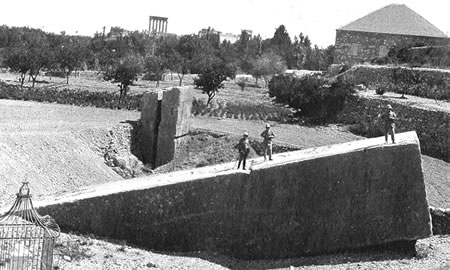 The hilltop of Tell Baalbek, part of a valley to the east of the northern Beqaa Valley (Latin: Coelesyria), shows signs of almost continual habitation over the last 8–9000 years. It was well-watered both from a stream running from the Rās-el-ʿAin spring SE of the citadel and, during the spring, from numerous rills formed by meltwater from the Anti-Lebanons. Macrobius later credited the site's foundation to a colony of Egyptian or Assyrian priests.
The hilltop of Tell Baalbek, part of a valley to the east of the northern Beqaa Valley (Latin: Coelesyria), shows signs of almost continual habitation over the last 8–9000 years. It was well-watered both from a stream running from the Rās-el-ʿAin spring SE of the citadel and, during the spring, from numerous rills formed by meltwater from the Anti-Lebanons. Macrobius later credited the site's foundation to a colony of Egyptian or Assyrian priests.
The settlement's religious, commercial, and strategic importance was minor enough, however, that it is never mentioned in any known Assyrian or Egyptian record, unless under another name. Its enviable position in a fertile valley, major watershed, and along the route from Tyre to Palmyra should have made it a wealthy and splendid site from an early age.
During the Canaanite period, the local temples were largely devoted to the Heliopolitan Triad: a male god (Baʿal), his consort (Ashtart), and their son (Adon). The site of the present Temple of Jupiter was probably the focus of earlier worship, as its altar was located at the hill's precise summit and the rest of the sanctuary raised to its level.
In Islamic mythology, the temple complex was said to have been a palace of Solomon's which was put together by djinn and given as a wedding gift to the Queen of Sheba; its actual Roman origin remained obscured by the citadel's medieval fortifications as late as the 16th-century visit of the Polish prince Radziwiłł.
Antiquity
Following Alexander the Great's conquest of Persia in the 330s BC, Baalbek (under its Hellenic name Heliopolis) formed part of the Diadochi kingdoms of Egypt & Syria. It was annexed by the Romans during their eastern wars. The settlers of the Roman colony Colonia Julia Augusta Felix Heliopolitana may have arrived as early as the time of Caesar but were more probably the veterans of the 5th and 8th Legions under Augustus, during which time it hosted a Roman garrison. From 15 BC to AD 193, it formed part of the territory of Berytus. It is mentioned in Josephus, Pliny, Strabo, and Ptolemy and on coins of nearly every emperor from Nerva to Gallienus. The 1st-century Pliny did not number it among the Decapolis, the "Ten Cities" of Coelesyria, while the 2nd-century Ptolemy did. The population likely varied seasonally with market fairs and the schedules of the Indian monsoon and caravans to the coast and interior.
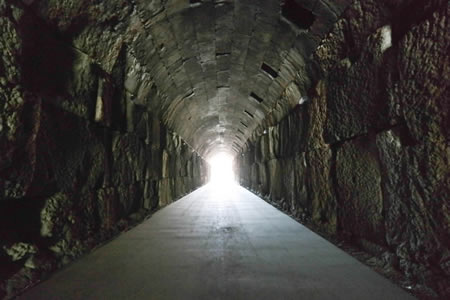 During Classical Antiquity, the city's temple to Ba'al Haddu was conflated first with the worship of the Greek sun god Helios and then with the Greek and Roman sky god under the name "Heliopolitan Zeus" or "Jupiter". The present Temple of Jupiter presumably replaced an earlier one using the same foundation; it was constructed during the mid-1st century and probably completed around AD 60. His idol was a beardless golden god in the pose of a charioteer, with a whip raised in his right hand and a thunderbolt and stalks of grain in his left; its image appeared on local coinage and it was borne through the streets during several festivals throughout the year. Macrobius compared the rituals to those for Diva Fortuna at Antium and says the bearers were the principal citizens of the town, who prepared for their role with abstinence, chastity, and shaved heads. In bronze statuary attested from Byblos in Phoenicia and Tortosa in Spain, he was encased in a pillarlike term and surrounded (like the Greco-Persian Mithras) by busts representing the sun, moon, and five known planets. In these statues, the bust of Mercury is made particularly prominent; a marble stela at Massilia in Transalpine Gaul shows a similar arrangement but enlarges Mercury into a full figure. Local cults also revered the Baetylia, black conical stones considered sacred to Ba'al. One of these was taken to Rome by the emperor Elagabalus, a former priest "of the sun" at nearby Emesa, who erected a temple for it on the Palatine Hill. Heliopolis was a noted oracle and pilgrimage site, whence the cult spread far afield, with inscriptions to the Heliopolitan god discovered in Athens, Rome, Pannonia, Venetia, Gaul, and near the Wall in Britain. The Roman temple complex grew up from the early part of the reign of Augustus in the late 1st century BC until the rise of Christianity in the 4th century. (The 6th-century chronicles of John Malalas of Antioch, which claimed Baalbek as a "wonder of the world", credited most of the complex to the 2nd-century Antoninus Pius, but it is uncertain how reliable his account is on the point.) By that time, the complex housed three temples on Tell Baalbek: one to Jupiter Heliopolitanus (Ba'al), one to Venus Heliopolitana (Ashtart), and a third to Bacchus. On a nearby hill, a fourth temple was dedicated to the third figure of the Heliopolitan Triad, Mercury (Adon or Seimios). Ultimately, the site vied with Praeneste in Italy as the two largest sanctuaries in the Western world.
During Classical Antiquity, the city's temple to Ba'al Haddu was conflated first with the worship of the Greek sun god Helios and then with the Greek and Roman sky god under the name "Heliopolitan Zeus" or "Jupiter". The present Temple of Jupiter presumably replaced an earlier one using the same foundation; it was constructed during the mid-1st century and probably completed around AD 60. His idol was a beardless golden god in the pose of a charioteer, with a whip raised in his right hand and a thunderbolt and stalks of grain in his left; its image appeared on local coinage and it was borne through the streets during several festivals throughout the year. Macrobius compared the rituals to those for Diva Fortuna at Antium and says the bearers were the principal citizens of the town, who prepared for their role with abstinence, chastity, and shaved heads. In bronze statuary attested from Byblos in Phoenicia and Tortosa in Spain, he was encased in a pillarlike term and surrounded (like the Greco-Persian Mithras) by busts representing the sun, moon, and five known planets. In these statues, the bust of Mercury is made particularly prominent; a marble stela at Massilia in Transalpine Gaul shows a similar arrangement but enlarges Mercury into a full figure. Local cults also revered the Baetylia, black conical stones considered sacred to Ba'al. One of these was taken to Rome by the emperor Elagabalus, a former priest "of the sun" at nearby Emesa, who erected a temple for it on the Palatine Hill. Heliopolis was a noted oracle and pilgrimage site, whence the cult spread far afield, with inscriptions to the Heliopolitan god discovered in Athens, Rome, Pannonia, Venetia, Gaul, and near the Wall in Britain. The Roman temple complex grew up from the early part of the reign of Augustus in the late 1st century BC until the rise of Christianity in the 4th century. (The 6th-century chronicles of John Malalas of Antioch, which claimed Baalbek as a "wonder of the world", credited most of the complex to the 2nd-century Antoninus Pius, but it is uncertain how reliable his account is on the point.) By that time, the complex housed three temples on Tell Baalbek: one to Jupiter Heliopolitanus (Ba'al), one to Venus Heliopolitana (Ashtart), and a third to Bacchus. On a nearby hill, a fourth temple was dedicated to the third figure of the Heliopolitan Triad, Mercury (Adon or Seimios). Ultimately, the site vied with Praeneste in Italy as the two largest sanctuaries in the Western world.
The emperor Trajan consulted the site's oracle twice. The first time, he requested a written reply to his sealed and unopened question; he was favorably impressed by the god's blank reply as his own paper had been empty. He then inquired whether he would return alive from his wars against Parthia and received in reply a centurion's vine staff, broken to pieces. In AD 193, Septimius Severus granted the city ius Italicum rights. His wife Julia Domna and son Caracalla toured Egypt and Syria in AD 215; inscriptions in their honour at the site may date from that occasion; Julia was a Syrian native whose father had been an Emesan priest "of the sun" like Elagabalus.
The town became a battleground upon the rise of Christianity. Early Christian writers such as Eusebius (from nearby Caesarea) repeatedly execrated the practices of the local pagans in their worship of the Heliopolitan Venus. In AD 297, the actor Gelasinus converted in the middle of a scene mocking baptism; his public profession of faith provoked the audience to drag him from the theater and stone him to death. In the early 4th century, the deacon Cyril defaced many of the idols in Heliopolis; he was killed and (allegedly) cannibalised. Around the same time, Constantine, though not yet a Christian, demolished the goddess's temple, raised a basilica in its place, and outlawed the locals' ancient custom of prostituting women before marriage. Bar Hebraeus also credited him with ending the locals' continued practice of polygamy. The enraged locals responded by raping and torturing Christian virgins. They reäcted violently again under the freedom permitted to them by Julian the Apostate. The city was so noted for its hostility to the Christians that Alexandrians were banished to it as a special punishment. The Temple of Jupiter, already greatly damaged by earthquakes, was demolished under Theodosius in 379 and replaced by another basilica (now lost), using stones scavenged from the pagan complex. The Easter Chronicles states he was also responsible for destroying all the lesser temples and shrines of the city. Around the year 400, Rabbula, the future bishop of Edessa, attempted to have himself martyred by disrupting the pagans of Baalbek but was only thrown down the temple stairs along with his companion. It became the seat of its own bishop as well. Under the reign of Justinian, eight of the complex's Corinthian columns were disassembled and shipped to Constantinople for incorporation in the rebuilt Hagia Sophia sometime between 532 and 537. Michael the Syrian claimed the golden idol of Heliopolitan Jupiter was still to be seen during the reign of Justin II (560s & 570s), and, up to the time of its conquest by the Muslims, it was renowned for its palaces, monuments, and gardens.
Excavations
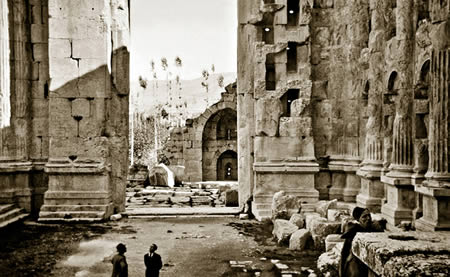 Emperor Wilhelm II of Germany and his wife passed through Baalbek on November 1, 1898, on his way to Jerusalem. He noted both the magnificence of the Roman remains and the drab condition of the modern settlement. It was expected at the time that natural disasters, winter frosts, and the raiding of building materials by the city's residents would shortly ruin the remaining ruins. The archaeological team he dispatched began work within a month. Despite finding nothing they could date prior to Baalbek's Roman occupation, Puchstein and his associates worked until 1904 and produced a meticulously researched and thoroughly illustrated series of volumes. Later excavations under the Roman flagstones in the Great Court unearthed three skeletons and a fragment of Persian pottery dated to the 6th–4th centuries BC. The sherd featured cuneiform letters. In 1977, Jean-Pierre Adam made a brief study suggesting most of the large blocks could have been moved on rollers with machines using capstans and pulley blocks, a process which he theorised could use 512 workers to move a 557 tonnes (614 tons). "Baalbek, with its colossal structures, is one of the finest examples of Imperial Roman architecture at its apogee", UNESCO reported in making Baalbek a World Heritage Site in 1984. When the committee inscribed the site, it expressed the wish that the protected area include the entire town within the Arab walls, as well as the southwestern extramural quarter between Bastan-al-Khan, the Roman site and the Mameluk mosque of Ras-al-Ain. Lebanon's representative gave assurances that the committee's wish would be honoured. Recent cleaning operations at the Temple of Jupiter discovered the deep trench at its edge, whose study pushed back the date of Tell Baalbek's settlement to the PPNB Neolithic. Finds included pottery sherds including a spout dating to the early Bronze Age. In the summer of 2014, a team from the German Archaeological Institute led by Jeanine Abdul Massih of the Lebanese University discovered a sixth, much larger stone suggested to be the world's largest ancient block. The stone was found underneath and next to the Stone of the Pregnant Woman ("Hajjar al-Hibla") and measures around 19.6 m × 6 m × 5.5 m (64 ft × 20 ft × 18 ft). It is estimated to weigh 1,650 tonnes (1,820 tons).
Emperor Wilhelm II of Germany and his wife passed through Baalbek on November 1, 1898, on his way to Jerusalem. He noted both the magnificence of the Roman remains and the drab condition of the modern settlement. It was expected at the time that natural disasters, winter frosts, and the raiding of building materials by the city's residents would shortly ruin the remaining ruins. The archaeological team he dispatched began work within a month. Despite finding nothing they could date prior to Baalbek's Roman occupation, Puchstein and his associates worked until 1904 and produced a meticulously researched and thoroughly illustrated series of volumes. Later excavations under the Roman flagstones in the Great Court unearthed three skeletons and a fragment of Persian pottery dated to the 6th–4th centuries BC. The sherd featured cuneiform letters. In 1977, Jean-Pierre Adam made a brief study suggesting most of the large blocks could have been moved on rollers with machines using capstans and pulley blocks, a process which he theorised could use 512 workers to move a 557 tonnes (614 tons). "Baalbek, with its colossal structures, is one of the finest examples of Imperial Roman architecture at its apogee", UNESCO reported in making Baalbek a World Heritage Site in 1984. When the committee inscribed the site, it expressed the wish that the protected area include the entire town within the Arab walls, as well as the southwestern extramural quarter between Bastan-al-Khan, the Roman site and the Mameluk mosque of Ras-al-Ain. Lebanon's representative gave assurances that the committee's wish would be honoured. Recent cleaning operations at the Temple of Jupiter discovered the deep trench at its edge, whose study pushed back the date of Tell Baalbek's settlement to the PPNB Neolithic. Finds included pottery sherds including a spout dating to the early Bronze Age. In the summer of 2014, a team from the German Archaeological Institute led by Jeanine Abdul Massih of the Lebanese University discovered a sixth, much larger stone suggested to be the world's largest ancient block. The stone was found underneath and next to the Stone of the Pregnant Woman ("Hajjar al-Hibla") and measures around 19.6 m × 6 m × 5.5 m (64 ft × 20 ft × 18 ft). It is estimated to weigh 1,650 tonnes (1,820 tons).
Ruins
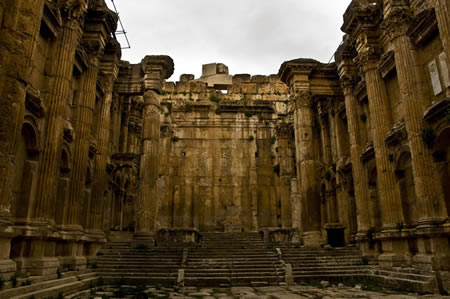 The Tell Baalbek temple complex, fortified as the town's citadel during the Middle Ages, was constructed from local stone, mostly white granite and a rough white marble. Over the years, it has suffered from the region's numerous earthquakes, the iconoclasm of Christian and Muslim lords, and the reuse of the temples' stone for fortification and other construction. The nearby Qubbat Duris, a 13th-century Muslim shrine on the old road to Damascus, is built out of granite columns, apparently removed from Baalbek. Further, the jointed columns were once banded together with iron; many were gouged open or toppled by the emirs of Damascus to get at the metal. As late as the 16th century, the Temple of Jupiter still held 27 standing columns out an original 58; there were only nine before the 1759 earthquakes and six today.
The Tell Baalbek temple complex, fortified as the town's citadel during the Middle Ages, was constructed from local stone, mostly white granite and a rough white marble. Over the years, it has suffered from the region's numerous earthquakes, the iconoclasm of Christian and Muslim lords, and the reuse of the temples' stone for fortification and other construction. The nearby Qubbat Duris, a 13th-century Muslim shrine on the old road to Damascus, is built out of granite columns, apparently removed from Baalbek. Further, the jointed columns were once banded together with iron; many were gouged open or toppled by the emirs of Damascus to get at the metal. As late as the 16th century, the Temple of Jupiter still held 27 standing columns out an original 58; there were only nine before the 1759 earthquakes and six today.
The complex is located on an immense raised plaza erected 5 m (16 ft) over an earlier T-shaped base consisting of a podium, staircase, and foundation walls. These walls were built from about 24 monoliths, at their lowest level weighing approximately 300 tonnes (330 tons) each. The tallest retaining wall, on the west, has a second course of monoliths containing the famous "Three Stones", a row of three stones, each over 19 m (62 ft) long, 4.3 m (14 ft) high, and 3.6 m (12 ft) broad, cut from limestone. They weigh approximately 800 tonnes (880 tons) each. A fourth, still larger stone is called the Stone of the Pregnant Woman: it lies unused in a nearby quarry 800 m (2,600 ft) from the town. Its weight, often exaggerated, is estimated at 1,000 tonnes (1,100 tons). A fifth, still larger stone weighing approximately 1,200 tonnes (1,300 tons) lies in the same quarry. This quarry was slightly higher than the temple complex, so no lifting was required to move the stones. Through the foundation there run three enormous passages the size of railway tunnels.
The temple complex was entered from the east through the Propylaeum or Portico, consisting of a broad staircase rising 20 feet (6.1 m) to an arcade of 12 columns flanked by 2 towers. Most of the columns have been toppled and the stairs were entirely dismantled for use in the nearby later wall, but a Latin inscription remains on several of their bases stating that Longinus, a lifeguard of the 1st Parthian Legion, and Septimius, a freedman, gilded their capitals with bronze in gratitude for the safety of Septimius Severus's son Antoninus Caracalla and empress Julia Domna.
Immediately behind the Propylaeum is a hexagonal forecourt reached through a threefold entrance that was added in the mid-3rd century by the emperor Philip the Arab. Traces remain of the two series of columns which once encircled it, but its original function remains uncertain. Donne reckoned it as the town's forum. Badly preserved coins of the era led some to believe this was a sacred cypress grove, but better specimens show that the coins displayed a single stalk of grain instead.
The rectangular Great Court to its west covers around 3 or 4 acres (1.2 or 1.6 ha) and included the main altar for burnt offering, with mosaic-floored lustration basins to its north and south, a subterranean chamber, and three underground passageways 17 ft (5.2 m) wide by 30 ft (9.1 m) high, two of which run east and west and the third connecting them north and south, all bearing inscriptions suggesting their occupation by Roman soldiers. These were surrounded by Corinthian porticoes, one of which was never completed. The columns' bases and capitals were of limestone; the shafts were monoliths of highly polished red Egyptian granite 7.08 m (23.2 ft) high. Six remain standing, out of an original 128. Inscriptions attest that the court was once adorned by portraits of Marcus Aurelius's daughter Sabina, Septimius Severus, Gordian, and Velius Rufus, dedicated by the city's Roman colonists. The entablature was richly decorated but now mostly ruined. A westward-facing basilica was constructed over the altar during the reign of Theodosius; it was later altered to make it eastward-facing like most Christian churches.
Trilithon
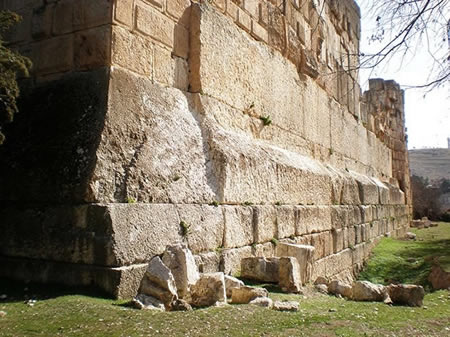 The Temple of Jupiter—once wrongly credited to Helios — lay at the western end of the Great Court, raised another 7 m (23 ft) on a 47.7 m × 87.75 m (156.5 ft × 287.9 ft) platform reached by a wide staircase. Under the Byzantines, it was also known as the "Trilithon" from the three massive stones in its foundation and, when taken together with the forecourt and Great Court, it is also known as the Great Temple. The Temple of Jupiter proper was circled by a peristyle of 54 unfluted Corinthian columns: 10 in front and back and 19 along each side. The temple was ruined by earthquakes, destroyed and pillaged for stone under Theodosius, and 8 columns were taken to Constantinople (Istanbul) under Justinian for incorporation into the Hagia Sophia. Three fell during the late 18th century. 6 columns, however, remain standing along its south side with their entablature. Their capitals remain nearly perfect on the south side, while the Beqaa's winter winds have worn the northern faces almost bare. The architrave and frieze blocks weigh up to 60 tonnes (66 tons) each, and one corner block over 100 tonnes (110 tons), all of them raised to a height of 19 m (62.34 ft) above the ground. Individual Roman cranes were not capable of lifting stones this heavy. They may have simply been rolled into position along temporary earthen banks from the quarry or multiple cranes may have been used in combination. They may also have alternated sides a little at a time, filling in supports underneath each time. The Julio-Claudian emperors enriched its sanctuary in turn. In the mid-1st century, Nero built the tower-altar opposite the temple. In the early 2nd century, Trajan added the temple's forecourt, with porticos of pink granite shipped from Aswan at the southern end of Egypt.
The Temple of Jupiter—once wrongly credited to Helios — lay at the western end of the Great Court, raised another 7 m (23 ft) on a 47.7 m × 87.75 m (156.5 ft × 287.9 ft) platform reached by a wide staircase. Under the Byzantines, it was also known as the "Trilithon" from the three massive stones in its foundation and, when taken together with the forecourt and Great Court, it is also known as the Great Temple. The Temple of Jupiter proper was circled by a peristyle of 54 unfluted Corinthian columns: 10 in front and back and 19 along each side. The temple was ruined by earthquakes, destroyed and pillaged for stone under Theodosius, and 8 columns were taken to Constantinople (Istanbul) under Justinian for incorporation into the Hagia Sophia. Three fell during the late 18th century. 6 columns, however, remain standing along its south side with their entablature. Their capitals remain nearly perfect on the south side, while the Beqaa's winter winds have worn the northern faces almost bare. The architrave and frieze blocks weigh up to 60 tonnes (66 tons) each, and one corner block over 100 tonnes (110 tons), all of them raised to a height of 19 m (62.34 ft) above the ground. Individual Roman cranes were not capable of lifting stones this heavy. They may have simply been rolled into position along temporary earthen banks from the quarry or multiple cranes may have been used in combination. They may also have alternated sides a little at a time, filling in supports underneath each time. The Julio-Claudian emperors enriched its sanctuary in turn. In the mid-1st century, Nero built the tower-altar opposite the temple. In the early 2nd century, Trajan added the temple's forecourt, with porticos of pink granite shipped from Aswan at the southern end of Egypt.
Temple of Bacchus
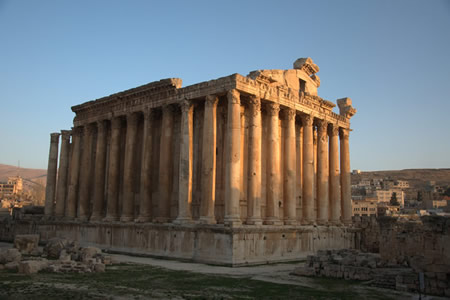 The Temple of Bacchus—once wrongly credited to Jupiter — may have been completed under Septimius Severus in the 190s, as his coins are the first to show it beside the Temple of Jupiter. It is the best preserved of the sanctuary's structures, as the other rubble from its ruins protected it. It is enriched by some of the most refined reliefs and sculpture to survive from antiquity. The temple is surrounded by forty-two columns — 8 along each end and 15 along each side — nearly 20 m (66 ft) in height. These were probably erected in a rough state and then rounded, polished, and decorated in position. The entrance was preserved as late as Pococke and Wood, but the keystone of the lintel had slid 2 ft (1 m) following the 1759 earthquakes; a column of rough masonry was erected in the 1860s or '70s to support it. The 1759 earthquakes also damaged the area around the soffit's famed inscription of an eagle, which was entirely covered by the keystone's supporting column.The area around the inscription of the eagle was greatly damaged by the 1759 earthquake. The interior of the temple is divided into a 98 ft (30 m) nave and a 36 ft (11 m) adytum or sanctuary on a platform raised 5 ft (2 m) above it and fronted by 13 steps. The screen between the two sections once held reliefs of Neptune, Triton, Arion and his dolphin, and other marine figures but these have been lost. The temple was used as a kind of donjon for the medieval Arab and Turkish fortifications, although its eastern steps were lost sometime after 1688. Much of the portico was incorporated into a huge wall directly before its gate, but this was demolished in July 1870 by Barker on orders from Syria's governor Rashid Pasha. Two spiral staircases in columns on either side of the entrance lead to the roof.
The Temple of Bacchus—once wrongly credited to Jupiter — may have been completed under Septimius Severus in the 190s, as his coins are the first to show it beside the Temple of Jupiter. It is the best preserved of the sanctuary's structures, as the other rubble from its ruins protected it. It is enriched by some of the most refined reliefs and sculpture to survive from antiquity. The temple is surrounded by forty-two columns — 8 along each end and 15 along each side — nearly 20 m (66 ft) in height. These were probably erected in a rough state and then rounded, polished, and decorated in position. The entrance was preserved as late as Pococke and Wood, but the keystone of the lintel had slid 2 ft (1 m) following the 1759 earthquakes; a column of rough masonry was erected in the 1860s or '70s to support it. The 1759 earthquakes also damaged the area around the soffit's famed inscription of an eagle, which was entirely covered by the keystone's supporting column.The area around the inscription of the eagle was greatly damaged by the 1759 earthquake. The interior of the temple is divided into a 98 ft (30 m) nave and a 36 ft (11 m) adytum or sanctuary on a platform raised 5 ft (2 m) above it and fronted by 13 steps. The screen between the two sections once held reliefs of Neptune, Triton, Arion and his dolphin, and other marine figures but these have been lost. The temple was used as a kind of donjon for the medieval Arab and Turkish fortifications, although its eastern steps were lost sometime after 1688. Much of the portico was incorporated into a huge wall directly before its gate, but this was demolished in July 1870 by Barker on orders from Syria's governor Rashid Pasha. Two spiral staircases in columns on either side of the entrance lead to the roof.
Temple of Venus
The Temple of Venus — also known as the Circular Temple or Nymphasum — was added under Septimius Severus in the early 3rd century but destroyed under Constantine, who raised a basilica in its place. Jessup considered it the "gem of Baalbek". It lies about 150 yd (140 m) from the southeast corner of the Temple of Bacchus. It was known in the 19th century as El Barbara or Barbarat el-Atikah (St Barbara's), having been used as a Greek Orthodox church into the 18th century.
Fortifications
The ancient walls of Heliopolis had a circumference of a little less than 4 mi (6 km). Much of the extant fortifications around the complex date to the 13th century reconstruction undertaken by the Mamluk sultan Qalawun following the devastation of the earlier defenses by the Mongol army under Kitbuqa. This includes the great southeast tower. The earliest round of fortifications were two walls to the southwest of the Temples of Jupiter and Bacchus. The original southern gateway with two small towers was filled in and replaced by a new large tower flanked by curtains, probably under Buri or Zengi. Bahram Shah replaced that era's southwest tower with one of his own in 1213 and built another in the northwest in 1224; the west tower was probably strengthened around the same time. An inscription dates the barbican-like strengthening of the southern entrance to around 1240. Qalawun relocated the two western curtains nearer to the western tower, which was rebuilt with great blocks of stone. The barbican was repaired and more turns added to its approach. From around 1300, no alterations were made to the fortifications apart from repairs such as Sultan Barkuk's restoration of the moat in preparation for Timur's arrival.
Material from the ruins is incorporated into a ruined mosque north of downtown and probably also in the Qubbat Duris on the road to Damascus. In the 19th century, a "shell-topped canopy" from the ruins was used nearby as a mihrab, propped up to show locals the direction of Mecca for their daily prayers.
Gallery
More Video
Megalithic Builders is an index of ancient sites from around the world that contain stone megaliths or interlocking stones. Genus Dental Sacramento

